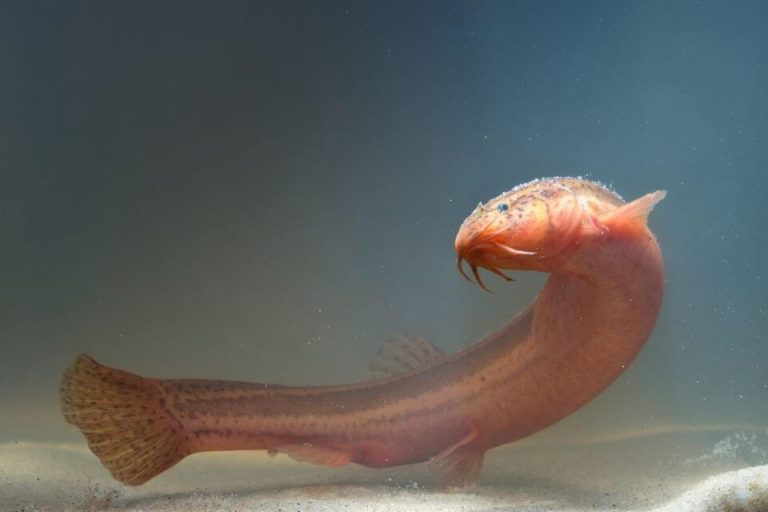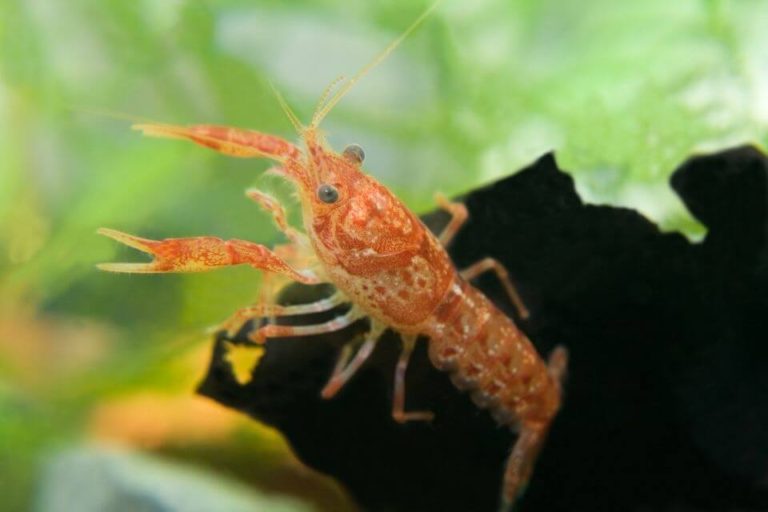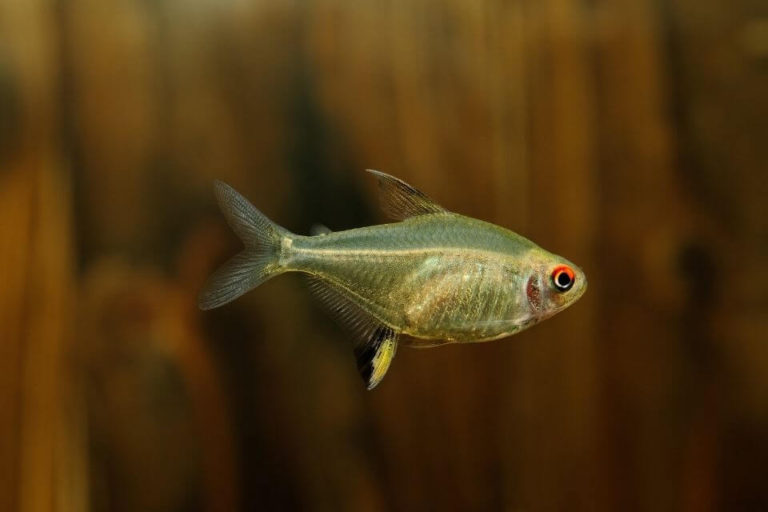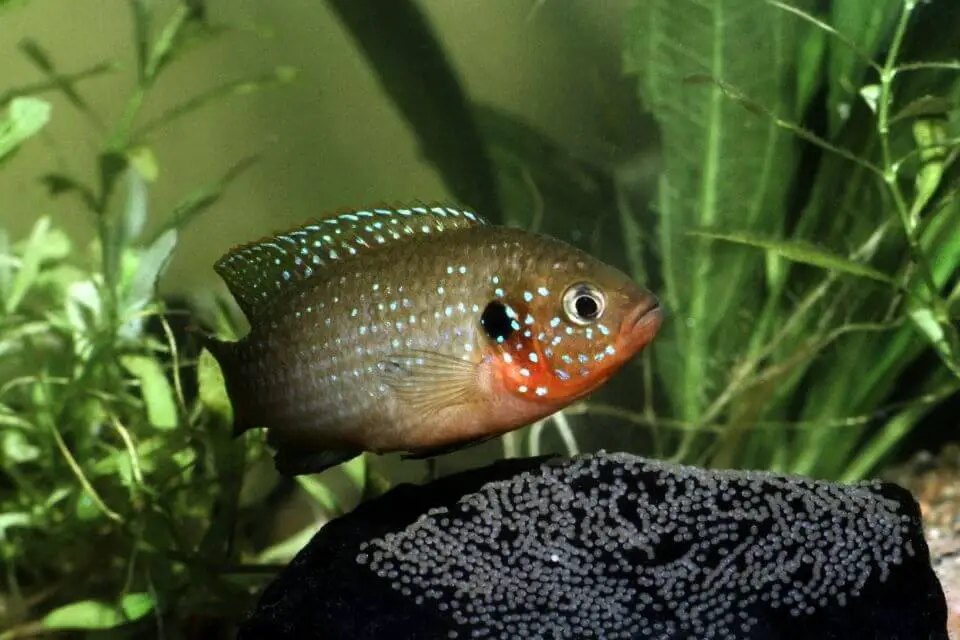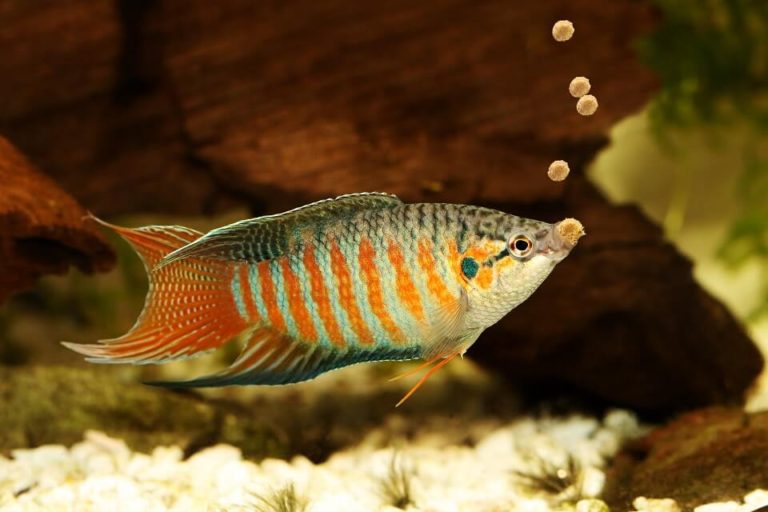Convict Cichlid Care: Size, Lifespan, Diet, Tank Mates, Tank Size & More..
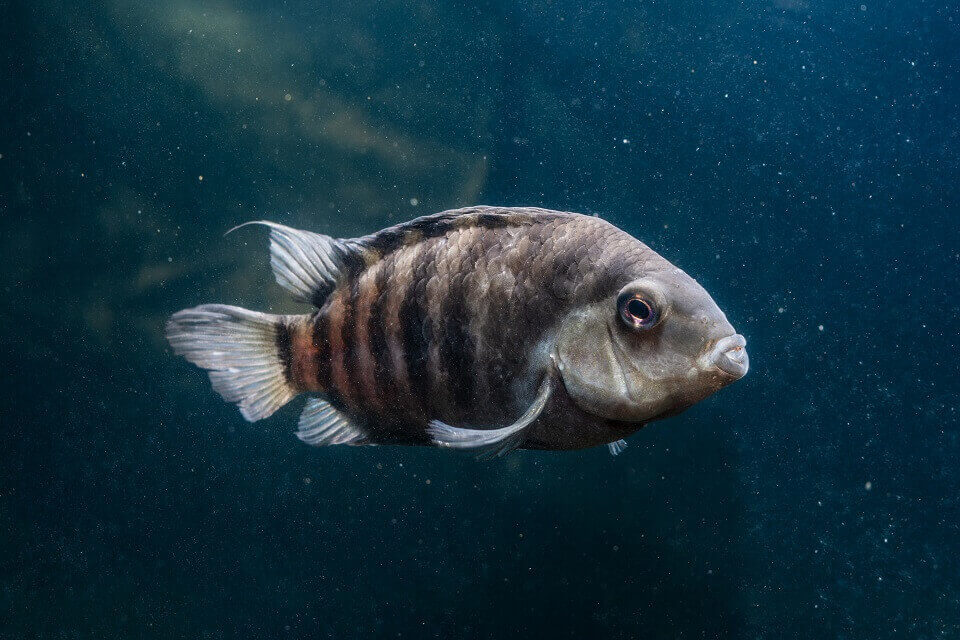
Convict Cichlid sometimes called Zebra Cichlid is an incredible fish to keep in your aquarium. Its coloring and commitment to protect and care for the fry are why many people are in love with this fish species.
Aquarists love Convict Cichlid because it is easy to look after and breed. It is a pretty easy fish to take care of and breed, making it perfect for beginners.
In this Convict Cichlid Care guide, we provide you with all the information you need to keep this stunning fish from its tank setup, tank conditions, tank mates, diet, and breeding.
| Quick Facts: | |
|---|---|
| Common Names | : Convict Cichlid, Zebra Cichlid |
| Scientific Name | : Amatitlania Nigrofasciata |
| Family | : Cichlidae |
| Origin | : Warm waters in South and Central America |
| Care Level | : Easy |
| Lifespan | : 8 - 10 years |
| Size (average) | : 4 - 6 inches long |
| Diet | : Omnivores |
| Breeding | : Egglayer |
| Social | : Territorial |
| Temperament | : Aggressive |
| Minimum Tank Size | : 30 gallons |
| Temperature | : 79 - 84° F (26 - 29° C) |
| Water Hardness | : 10 - 15 dGH |
| Water pH Level | : 6 - 8 |
Overview of Convict Cichlid
Convict Cichlid is scientifically known as Amatitlania Nigrofasciata. This beautiful freshwater fish is also referred to as Zebra Child because its black and white stripes look like a Zebra.
These stunning fish species are among the Cichlidae family’s popular members and are loved by fish keepers because they are hardy, low maintenance, and have vibrant hues. Convict Cichlid is also open to mating, making it perfect for beginners.
These species are aggressive and territorial, making it challenging to find tank mates. Breeders should place Zebra Cichlid together with other Convicts since they all have aggressive tendencies.
With optimal tank conditions, these feisty fish species can live for 8 to 10 years or beyond. They are found in the warm rivers and streams of South America. You will find the fish hiding in rocks and hollow logs.
Convict Cichlid Size
A fully grown Convict cichlid size has an average of approximately 4 to 5 inches. And compared to other Cichlid fish species, it is relatively small. The upside of having this beautiful fish is that you won’t need to purchase a big tank, thus saving on cost.
Basically, Convict cichlid size depends on the tank size and the care level that you receive. In a captivity environment, you will be able to give them better care easily.
Convict Cichlid Lifespan
Convict Cichlid lifespan is an average of about 8 to 10 years, provided optimal care is provided. In some rare instances, it has been reported that Convict Cichlid lifespan can exceed 10 years.
However, if you cannot provide optimal tank conditions, your fish dying chances before reaching eight years are high. If you want to enjoy having Convict Cichlid in your tank for eight years and above, buy a healthy fish from reputable suppliers.
Appearance, Colors, and Special Markings
The fish’s name stems from its black and white markings, similar to the clothes prisoners wear, hence Convict’s name. This fish is also referred to as Zebra Cichlid. Their color can vary depending on their age, gender, and type.
Although this article focuses on the most commonly white and black Convict Cichlid, it’s not a wonder to find Pseudo Zebra Cichlids that happen due to selective breeding and is white, pink, or gold.

A mature fish has around eight stripes, but they can be more or less dependent on its genetic component. And the rest of the fish’s body has a greyish-blue hue. Although this color can change, it is consistent in almost all the fish.
When making a purchase, fish keepers lookout for these stripes, and the more defined the bars are, the healthier the fish is. When the female is mature and ready to breed, it develops a yellowish-red hue on its belly.
The male convict Cichlids have large anal and dorsal fins, while the females’ are smaller and brighter. The dorsal fin and pectoral fin start from a fourth way from the fish’s mouth, and the dorsal continues to the start of the caudal fin.
The dorsal fin is semi-transparent, and the black and white bars extend a little into this fin. It is fun to watch this fish as the dorsal fin flap like a sail, creating an elegant visual effect.
The caudal fin is semi-transparent and average-sized. The fish stripe does not extend to this fin, and it helps the fish generate the powers needed to wade through the water with its symmetrical shape.
The fish has a classic body of a cichlid, almost similar to that of an African Cichlid. It’s difficult to distinguish between a male and female Zebra Cichlid until they have matured.
While many of the Cichlidae family members are large, Convicts are the smallest, with the male growing up to 6 inches and the females up to 4.5 inches.
Convict Cichlid Typical Behavior
Convict Cichlid is known for its aggressive and territorial temperament, typical behavior among the Cichlid family. This fish species is very active and does not like other fish encroaching on its territory.
Convicts defend their territory by chasing and eventually eating the other fish. This fish is very active and playful and spends its time swimming and playing inside the caves, hollow logs, and plants.
Therefore, ensure that your tank is spacious enough to allow the fish to move around and that its tank mates have enough hiding places.
These fish species are known for their parenting behavior, as they are attentive and protect their fry from being attacked and searching for food.
The tank size determines the fish’s behavior; the more the room, the less the likelihood of your fish feeling like its space is being encroached.
Convict Cichlid Care
In the wild, Convict Cichlids are found in the warm water rivers and streams across entire Central and South America. There are different types of these fishes that can be found in several countries along the Atlantic and Pacific Coast.
These countries include Guatemala, Honduras, and El Salvador. Some parts of Australia have suitable conditions for this fish, so it is not surprising to find this region’s fish species.
These stunning fish thrive in water bodies whose current is moderate, and the rivers, streams, and lakes have plenty of rocks and woods that act as hiding places.
Although people have been capturing this vibrant fish species excessively over the years, its population levels have not reached a point where it can be affected.
Before getting yourself some Zebra Cichlids, you need to understand their behavior and temperament, tank size, and water parameters. This will help you in planning their tank environments, diet, and choosing their tank mates.
– Convict Cichlid Tank Size
The best Convict Cichlids tank size for a single fish should be at least 30 gallons. This ensures that they have enough space to swim around, plant enough aquarium plants, and place rocks.
When your fish have enough space, their stress levels are reduced, ensuring that you have healthy fish, translating to a long life. But if you are planning to keep a pair, then at least 40 gallons tank is most appropriate.
– Convict Cichlids Tank Setup
Convict Cichlid is aggressive and territorial. Therefore, they have the right tank shape, long or wide, fitted with the right décor to contribute massively in making this fish species happy.
When setting up the tank, it’s always best to start with the substrate. Zebra Cichlids love to dig and uproot plants, so it’s best to place a sandy substrate because coarse substrate will scratch them.
Also, make sure to put a lot of driftwood, caves, floating plants, and rocks so they can play around and the places to hide.
You make sure that the stones and caves are firmly attached to the tank’s surface as they could cause accidents as the fish play. The lighting used in the tank should be suitable for the plants and fellow tank mates.
– Suitable Aquarium Plants
Since Convict Cichlids are known to uproot the plants, ensure that you use hardy aquarium plants that have a strong rooting system and a few Floating Plants such as:
- Java Moss
- Amazon Swords
- Water Lettuce
- Normal Salvinia
- Duckweed
- Hornwort
- Riccia Fluitans
- Anubias
- Amazon Frogbits
Expert’s Tip: Convict Cichlids are naughty and tend to rearrange your tank layout. Ensure that you have a robust filtration system, such as the Hang On Back (HOB) or Canister Filter.
– Water Temperature and Conditions
Convict Cichlid is a hardy fish species that can withstand a wide range of tank conditions. However, it’s always best to replicate their natural habitat when setting up an aquarium.
Ensure that the water flow is low and that the temperatures hover around 79 and 84 degrees Fahrenheit (26 to 29 °C). During the cold season, it is better to place a heater in your tank.
If you are only keeping Zebra Cichlid, water pH does not need a lot of attention since this fish species thrive in about any pH balance. However, if you have tank mates, you must monitor the water pH and ensure it ranges between 6 and 8.
The water hardness should be between 10 to 15 dGH (degree of General Hardness).
Convict Cichlid Food and Feeding
Convict Cichlids are not fussy eaters, and they will eat almost anything they come across. They are considered omnivorous as they eat both plants and meat. In the wild, they feed on plant debris, tiny insects, and mosquito larvae.
However, the goal of raising this fish species in your tank is to keep it healthy, so make sure that you plan the diet carefully.
We always recommend that you feed your Convict Cichlid with high-quality fish flakes and pellets produced explicitly for cichlids. You can also add live foods, such as Brine shrimp, Blood worms, Black worms, and Daphnia.
To have them balance their diet, add vegetables like Broccoli, Lettuce, and Carrots. These foods help in bringing out the fish’s coloration while encouraging its growth.
It would be best to feed your Zebra Cichlids two or three times a day and small portions that they can eat in a few minutes. The small potions prevent water pollution, which can destabilize the tank conditions, endangering the fish.
Common Diseases
Like other freshwater fish species, Convict Cichlids are susceptible to water diseases and illnesses such as Ich, Bloat, Fin rot, and Swim bladder disease.
The most common disease in freshwater fish species is Ich, which is caused by a Protozoan parasite, Ichthyophthirius Multifiliis. You will notice fine white spots on the fish’s gills, bodies, and fins.
Most often, before the spots appear, you will see your fish rubbing its body against the surface of the tanks, rocks, or caves.
Fortunately, you can treat Ich using over-the-counter antibacterial products or increasing water temperature to 86 degrees Fahrenheit for 2 to 3 days. But, pay close attention to your fish so that you can pinpoint any unusual activity on time.
Gender Differences of Convict Cichlid

It is effortless to distinguish between mature male and female Convict Cichlids. The males are to a certain degree larger than the females, and as they grow, you will notice a bump on the heads of the male Convicts, which is absent in females.
Another distinction to look for is in the fins; male Convict’s dorsal and anal fins are longer than females. More so, the female fins are more colorful than the males.
Mature female Convicts ready for breeding develop red bellies, which are absent in males. This helps in identifying a breeding pair, which is vital if you want to increase your fish.
Breeding the Convict Cichlid
Convict Cichlid is the easiest aquarium fish to breed and it makes for great parents. Ensure that you have a large tank, possibly 50+ gallons with a suitable layout.
You don’t need a perfect pair of Zebra Cichlids, just any male, and female who have reached the breeding stage and you are ready.
Convict Cichlids breed from a young age of 7 months when they reach maturity, and they will spawn all year round. In their natural habitat, Convicts Cichlids lay their eggs on the rocks and inside caves.
Therefore, you need to mimic their native home as much as possible in your freshwater aquarium. You can use clay pots to act as caves. Although Convicts are not selective with their mating partner, they are picky about their mating place.
Do not bother yourself with the safety of the eggs because Convicts Cichlids are role model parents. The female fish guard the eggs as they prepare to hatch while the males swim around, warding off any fish that comes across.
Once they hatch, the parents will help their fry find food and create safe places for them to hide. They will also fight off any fish species that threaten their lives; that’s why you will never find a Convict Cichlid fry losing its life.
After a few days, they break their yolk and start to swim. During this stage, it’s essential to remove them from the communal tank as the male Convict can be aggressive towards the juvenile Convicts.
Convict Cichlid Tank Mates
The number of fish that can coexist with Convict Cichlids is limited because of their aggressive and territorial behavior. That’s why it’s important to use a large aquarium if you plan on adding tank mates.
It would be best never to use peaceful fish as Convict Cichlid tank mates because they will be harassed and eventually become a meal.
The best Convict Cichlid tank mates include:
- Green Terror
- Jewel Cichlids
- Firemouth Cichlids
- Rainbow Cichlids
- Texas Cichlids
- Blue Acara
- Red Devils Cichlids
- Common Plecos
- Giant Danios
- Flowerhorn Cichlids
If you decide to add any other type of fish, make sure they are fast enough to escape and hide if Convicts decide to play hide and seek. It is recommended that you place larger fish than convicts as tank mates, but we cannot guarantee their safety.
Origin, Distribution, and Availability
Convict Cichlid is found in warm rivers, lakes, ponds, and streams across South and Central America. They are also found in countries that harbor the Atlantic and Pacific Coast, such as Guatemala, Honduras, El Salvador, and Costa Rica.
You can also find them in some parts of Australia where the rivers and streams are conducive for this fish species.
These fish species thrive in slow-moving warm waters with rocky bottoms. Their natural habitat comprises a sandy substrate, logs, and driftwood that act as hiding and breeding grounds.
Convict Cichlids are omnivorous and feed on anything that comes their way, such as plant debris, tiny insects, and mosquito larvae.
You can buy Convict Cichlids from your local aquarium store, or you can order online, and they will be delivered to your doorstep. In some fish stores, this vibrant fish is advertised as Zebra Cichlid.
There are various convicts called White Convicts, Pink Convicts, Albino Convicts, and Gold Convicts. When shopping for this fish species, look for reputable suppliers around you.
FAQs
Can Convicts Live with African Cichlids?
Possibly, if you have a large tank, Convicts and African Cichlids will coexist amidst many aggressive fights since they are both from a bold family. But if your tank is small, be prepared for an aggressive coup.
Are Convict Fish Aggressive?
Yes. All Cichlids are aggressive; therefore, expect your Convict Cichlids to be aggressive and territorial species that are hard to find tank mates.
If you place them with other fish kinds, particularly the peaceful ones, they will hound them to exhaustion and then eat them to the bones.
Will Convict Cichlids Eat Other Fish?
Yes. If you put other tank mates that cannot stand for themselves, chances are they will be thoroughly harassed and then eaten by Convict Cichlid. Convicts are aggressive and territorial and can eat even fish that are twice their size.
Suppose you want to put other tank mates, best to put other Central American Cichlids, preferably a mate. Otherwise, any other fish type will face the same fate, death, and be eaten to the bones.
Do Convict Cichlids Have Teeth?
Yes. All Cichlids have teeth. While some Cichlids have a row of teeth, others have fang-like teeth useful in trapping and eating other fish.
Convict Cichlids have a row of fully developed teeth in their throat and another set of regular teeth found in the mouth.
How Many Convict Cichlids Can Be In a Tank?
Convict Cichlids are aggressive and territorial, so it’s recommended that you keep one Convict Cichlid in a 30 gallons tank. But if you want to keep several, it’s best to keep a pair, male and female, in a 40-plus gallons tank.
Suppose you want to keep more, ensure that you provide a massive tank, and even then, they will still fight. You can try maintaining a male-to-female ratio of 1:3 because having too many male species in a tank could lead to dominance trouble, so ensure plenty of females goes around.
Can We Put Convict Cichlid with Other Cichlids?
Yes. Because of their aggressive and territorial nature, Cichlids can only co-exist with other Cichlids. But make sure that you have a big tank, 50+ gallons, to ensure that they do not feel cramped up.
Is Convict Cichlid a Better Choice for My Aquarium? (Conclusion)
Although it’s challenging to get tank mates for Convict Cichlids because of their aggressive and territorial nature, they are pretty straightforward to take care of.
They are interesting species to watch because of their beautiful coloring and playful nature that keep them active. And don’t forget their parenting skills are something to admire.
They are a hardy fish species that can survive in a wide range of water conditions and are stress-free to look after, making them ideal for beginners.
Finally, this might be a good choice if you like to have aggressive fish species in your freshwater tank. We believe you find good information by reading this Convict Cichlid care guide.
If you have any questions please let us have your concern in the comment section below.



